Manifest Technology Blog
-- Site:
| Articles
| Galleries
| Resources
| DVI Tech
| About
| Site Map
|
Articles:
| PC Video
| Web Media
| DVD & CD
| Portable Media
| Digital Imaging
| Wireless Media
| Home Media
| Tech & Society
|
PC Video: |
PC Video Articles |
Video Software Gallery |
Video Editing Resources |
Affordable HD on the Desktop at NAB 2004
with Adobe Premiere Pro 1.5 (8/2004)
by Douglas Dixon
Getting HD On the Desktop
HD Formats
HDV Cameras
HD in Adobe Premiere Pro
- CineForm Aspect HD
- BOXX HD [pro] RT
- MainConcept MPEG Pro
Microsoft Windows Media Video HD
- Sonic Solutions DVD Producer- WMV HD Edition
Premiere HD Accelerators
- Matrox HD
- Canopus HD
- 1 Beyond HD Workstations
HD Video Capture
- Bluefish444 HD Fury / HD Lust
- Blackmagic DeckLink HD
HD Goes Mainstream
- DVCPRO HD - Apple Final Cut Pro HD
- Ulead - MediaStudio Pro 7
- HDV, - Avid HD - Xpress Pro
- DNxHD, - Pinnacle - Liquid HD
References
High Definition (HD) has been proclaimed the next great new thing --
for at least the past few years. The consumer electronics business has been
impatiently waiting for HD to really take off, hoping for a repeat of the
tremendous success of DVD. Meanwhile, the high definition business has continued
to grow, albeit at a steady pace, encouraged by the expanded availability of
content through broadcast networks and cable systems, and the falling prices and
competing technologies in high-def displays.
But for many content creators, corporate and independents, these early days
of HD were looking much like the beginnings of DVD, when the high cost of
production equipment and authoring tools restricted access to the new technology
only to major studios. But 2004 brings great news to videographers interested in
HD production, in the form of HD formats, equipment, and software that are
bringing affordable HD to the desktop.

HD production on the desktop was a major theme at the NAB (National
Association of Broadcasters) annual conference held in April in Las Vegas (www.nabshow.com).
With new cameras and video formats such as HDV, peripherals to import and export
high-definition formats, and editing software now capable of real-time editing
of HD material, high-def production is now in the reach of the rest of us who
work on desktop systems.
In this article, I'll outline this wide range of possibilities for HD desktop
editing from NAB, now available and coming soon. We'll focus on a variety of
approaches for working in HD in Adobe's new version of Premiere Pro 1.5, since
it has so much third-party support with software and hardware enhancements. And
we'll also explore other choices for HD from NAB, just to make sure that you
have enough different options to consider.
Working with HD on the desktop requires cost-effective solutions for the full
video production pipeline: shooting (tape format), ingest (capture process),
storage (disk file format), editing (video software), and delivery (delivery
file format or export). The storage and processing demands of higher-resolution
material requires new approaches throughout the production process, and also
introduces multiple competing formats to add more complexity to our work.
For the past few years, our industry has actually enjoyed a period of
relative sanity with the popularity of the DV format, as desktop videographers
could go end-to-end with DV: shooting on DV camcorders, import and export over
FireWire, and editing with a wide variety of tools on multiple platforms, with
all elements working with the same common DV data format.

Of course, production facilities also needed to work with a variety of other
professional video formats, analog and digital, such as Digital Betacam, DVCPRO,
and DVCAM. And it was already clear from the profusion of broadcast
formats defined for HD that there would not be any single ubiquitous format like
DV for the new high-def world. Instead, we will need to deal with multiple
resolutions, at a variety of historical frame rates frame rates, and with both
interlaced and progressive formats.
Even more, the fundamental issue with HD is that it is, well, high
resolution. Even lower-res HD (1280 x 720), is more than 2 1/2 times larger than
a standard definition (SD) frame (720 x 480). And higher-def HD (1920 x 1080),
is six times larger than SD. That's just a lot more data, in terms of both
storage requirements and data transfer speeds, stressing the ability for today's
systems to transfer the data (i.e., over FireWire), store and access it on hard
disk, or provide the processing power to provide real-time previews of editing
effects applied to multiple streams.
The fundamental conclusion for working with HD video is that you really have
to compress the video to make it feasible to transfer, store, and edit. Raw,
uncompressed 1920 x 1080 video (albeit with 4:2:2 reduced color) requires over
700 Mbps throughput, and over 300 GB of storage per hour of material. Compare
that to 25 Mbps for DV video, or around 10 GB per hour (HD has 6 times larger
resolution, with more color, and DV has around 5:1 compression).
The key questions, then, are how much to compress, and in what format, for
compatibility with other equipment and software. This involves trading off size,
quality, and ease of processing.
You can see a possible path in comparing DV and DVD compression: DV
compresses each frame independently at 25 Mbps, compared to using more
aggressive frame-to-frame MPEG-2 compression for DVD to reduce the rate another
4X to around 6 to 8 Mbps. So if HD is 6X larger resolution than SD, that
suggests MPEG-like compression can cut HD down to a manageable rate in the range
of DV, or certainly within the capacity of the FireWire interface, while
maintaining good quality.
The remaining question then is ease of editing. Formats like DV that compress
each frame independently are much easier to process than formats like MPEG that
compress groups of frames together by storing differences between frames.
Historically, editing MPEG has been problematical, both due to the work
requested to access and then update individual frames packed within the larger
group, and because repeated decompression and re-compression of these groups can
damage the image quality.
However, the technology for native MPEG editing has improved, so that it is
now built in to some video editing tools. And, unlike when editing SD video that
has been aggressively squeezed for delivery on DVD, HD video with MPEG-like
compression starts with very good quality for further editing.
Desktop editing also requires that new HD formats be integrated into the
desktop software environment, to interface with cameras for capture, and for
saving and editing the associated file formats. This can be done by creating
application-specific solutions that update the software to work with the format,
or by integrating with the platform's existing pipeline to support the new
compression format (via compression codecs) and possibly new file types.
Ideally, of course, you would like to be able to use the same format, like DV,
all through the pipeline, and also have it supported by any other video software
on your system. But with all the HD camera formats, it may well make sense to
transcode on capture to a common editing format, which also can preserve better
quality or be more compatible with the desktop video software environment.
Even among the announcements at NAB, you will see very different approaches
to addressing these issues, depending on your priorities and existing equipment.
JVC's answer to the desktop HD dilemma is the new HDV format,
announced in 2003 (www.hdv-info.org, www.jvc.com/pro);
see C&CV, May 2004). HDV is high-definition video stored on standard DV
cassette tape, and therefore is intended to be the basis of relatively
inexpensive cameras.
HDV is designed to fit the existing DV video processing pipeline by
compressing the video to DV rates so that it can be transferred over FireWire.
It uses a variant of the same MPEG compression format used for DVD. The initial
JVC JY-HD10U camera only shoots in 720p, compressed to approximately 19 Mbps,
but the HDV format does support 1080i at approximately 25 Mbps data rate (like
DV).
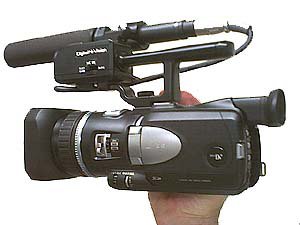 JVC Y-HD10U
JVC Y-HD10U
At NAB, JVC demonstrated additional HDV gear, including HD camcorders, studio
decks, and encoders. Sony also demonstrated a prototype HDV camera that supports
1080i, and you can expect other announcements soon (www.sony.com/professional).
Adobe also broadened its support for HD at NAB with the announcement of Premiere
Pro 1.5 (www.adobe.com/premierepro),
part of an upgrade to the entire Adobe Video Collection, also including After
Effects 6.5, Audition 1.5, and Encore DVD 1.5.
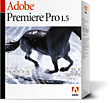
Premiere Pro provides a scalable architecture that supports real-time editing
from DV to HD.

As you will see, NAB also saw the announcement of a wide variety of
third-party enhancements for the Premiere platform, supporting editing different
HD formats directly in Premiere, and hardware accelerators for import, export,
and processing HD video.
- CineForm Aspect HD
Building on the HDV announcements in 2003, CineForm has created several
products for editing HD in Adobe Premiere, originally in Premiere 6.5, and now
in Premiere Pro 1.5 (www.cineform.com).
Aspect HD provides real-time multi-stream processing of high-definition video
within Premiere Pro. The new version 2.2 includes support for all HDV
resolutions and frame rates, from SD to 1080p30 HD. CineForm also is now
bundling the Adobe editing software suite with Aspect HD for $1199 (list).

CineForm has taken the approach of supporting HD editing by transcoding the
HDV video to its own format for editing. The CineForm format is actually less
compressed than HDV, at around 100 Mbps, but then can be stored in standard AVI
files and is easily accessible and editable by other Windows video software.
CineForm states that up to four HD streams can processed simultaneously in
real time, plus transitions, effects, and motion, on a 2.8GHz Pentium 4 PC and a
simple RAID 0 configuration.
- BOXX HD [pro] RT
The generation from CineForm is Prospect HD, which provides the same kind of
software-based video engine for real-time multi-stream editing, but stepped up
to full 10-bit HD video. Prospect HD is initially available exclusively on the
new BOXX Technologies HD [pro] RT system, a dual-processor turnkey PC
workstation, with pricing starting at $22,995 (www.boxxtech.com).
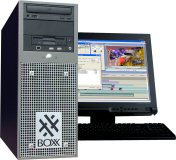
Prospect HD supports 8-bit and 10-bit precision, for virtually all HD
resolutions and frame rates up to 1080p 30. The HD [pro] RT accepts video input
from a variety HD sources including HD-SDI and HDV, which are converted to
CineForm format in real time for storage and processing using Premiere Pro.
BOXX states the system will process up to three 1080p 30 streams
simultaneously in real time, including color correction, effects, transitions,
titles and graphic overlays with motion.
The advantage of the CineForm approach is that you can work directly in your
standard tools with an HD format that is both high quality and efficient to
process, instead of needing to work offline with lower-res proxy video. You do
need to transcode on input (and output), but this also makes it easier to
support a variety of external formats.
- MainConcept MPEG Pro
An alternate approach for HD editing in Premiere is to just edit directly in
MPEG format, since it is so commonly used, from DVD to HDV. This is the idea
behind the MainConcept MPEG Pro plug-in (www.mainconcept.com).
The MainConcept MPEG encoders are already used in Premiere and other major video
applications, but the MPEG Pro plug-ins add the ability to natively edit MPEG
files directly in the timeline. You just select the appropriate editing preset.
Working directly in MPEG can significantly enhance your workflow by capturing,
editing, and exporting all in the same format (saving storage and even
immediately DVD-ready), without any additional conversions or rendering.

The MPEG Pro Standard Version supports SD editing up to DVD quality ($249),
and the HD Version supports editing at HD resolutions, including direct capture
from HDV camcorders ($349).
MainConcept describes MPEG Pro as supporting real-time performance at DVD
resolution, but is careful to state that the HD version supports HD editing, but
not acceleration.
Once you have finished editing your HD productions in Premiere or other
tools, the best available delivery format for computer playback is Microsoft's
Windows Media High Definition Video, WMV HD (www.microsoft.com/windowsmedia).

With Windows Media 9 Series on Windows XP, Microsoft has been working to
encourage the adoption of WMV well beyond the desktop, for everything from
handheld devices to set-top players to digital cinema. WMV HD provides a
high-quality HD format that provides good compression and can be played back on
today's higher-end computers, so you can play HD video on the monitor or feed it
out to a projector. You just export directly from the timeline in WMV HD format,
and you're ready to go.

Microsoft is working with the Society of Motion Picture and Television
Engineers (SMPTE) to standardize the Windows Media Video 9 codec, and WMV HD
also is being evaluated as a format for the next generation high-def DVD, HD
DVD. To explore movies in HD, check out recent DVD releases including Standing
in the Shadows of Motown, Terminator 2 Extreme Edition, Coral Reef Adventure,
Step Into Liquid. These two-DVD sets include the movie in standard DVD format on
the first disc, and then a second disc with all the usual extras and bonus
material, including the entire movie in HD, with surround sound, compressed to
fit in the spare space on the extra disc.
- Sonic Solutions DVD Producer- WMV HD Edition
And now you can create your own Windows Media HD DVDs, with the announcement
from Sonic Solutions of DVD Producer- WMV HD Edition (www.sonic.com).
Now in beta, and targeted for release in September 2004, this special version of
Sonic's DVD Producer authoring software will enable the creation of interactive
presentations using WMV HD material.

Since WMV HD presentations are played on PCs, and not on set-top players,
they can provide a DVD-like interactive experience, but enhanced to better
leverage the full capabilities of the PC platform.
- Matrox HD
One of the strengths of the Premiere product line has been its strong
integration with third-party video hardware, especially for video input/output
and acceleration. At NAB 2004, Matrox previewed Matrox HD, a new family of HD
editing products scheduled to be introduced later in 2004 (www.matrox.com).
The Matrox HD products are based on a new 10-bit architecture that supports
real-time performance with Premiere Pro, including color correction, titling,
speed changes, transitions, and DVEs (digital video effects). The products will
provide real-time acceleration beyond 720p HD, with real-time performance
extending to higher-resolution 1080i and 1080p.
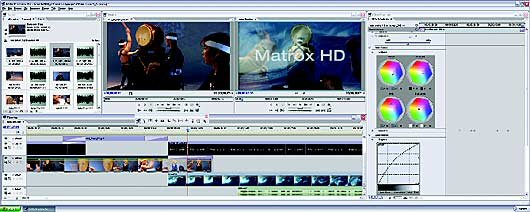
- Canopus HD
Canopus also demonstrated its own proprietary HD codec used for editing HD
material in Premiere Pro (www.canopus.com).
Canopus describes the Canopus HD format as creating clips that are one-seventh
the size of uncompressed HD, yet with image quality equivalent to that of
Panasonic DVCPRO HD and Sony HDCAM video.
Canopus also described a new Canopus HD I/O card to high-quality realtime
encoding and decoding of HD video streams within Premiere Pro. It captures HD
input from HD-D5, HDCAM or DVCPRO HD cameras and supports editing of Canopus HD
clips on the Premiere Pro timeline.
In addition, Canopus an upgrade to its EDIUS HD realtime HD editing system,
integrated with the HD codec and HD-SDI/SDI input and output card, to be
available in June 2004.
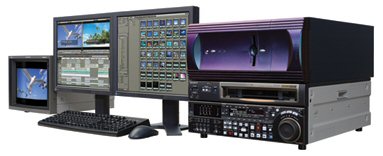
- 1 Beyond HD Workstations
If you are looking for a packaged high-end video editing system, check out 1
Beyond (www.1beyond.com). At NAB, 1 Beyond
announced the availability of a new line of HD systems, including the HD Pro
workstation digital nonlinear editing system starting under $30,000 and the HD
Pro Mobile luggable HD editing/compositing workstation you can use for offline
editing or HD projection. The HD Pro workstation features Adobe Premiere Pro
with 10-bit uncompressed HD editing and compositing as well as real time HDV, SD
and DV native formats.
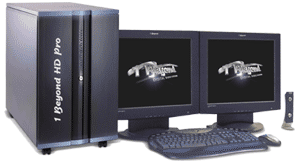
Of course, the common denominator input format for HD video is SDI (Serial
Digital Interface), so another approach to the ingest issue is to capture
uncompressed HD directly over SDI, and then transcode and edit as needed. This
approach is particularly useful when working on short clips such as effects,
when you can work in full-quality format without blowing out your available
storage.
However, conventional SD and HD-SDI use 4:2:2 video, with half-resolution
color data. For full color detail, you can use Dual Link HD-SDI, which uses two
HD-SDI cables for 4:4:4 video with full-resolution color.
- Bluefish444 HD Fury / HD Lust
Bluefish444, a division of Digital Voodoo in Australia (www.bluefish444.com),
demonstrated its HD Fury 10-bit uncompressed SD/HD-SDI video card (US$11,995),
with support for Premiere Pro 1.5 and After Effects 6.5. The HD Lust card
(US$15,995) adds Dual Link input and output, and keying. These cards include
simultaneous SD down conversion and 8 channels of digital audio.
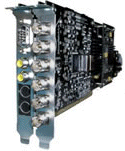 HD Lust
HD Lust
- Blackmagic DeckLink HD
Blackmagic Design of Australia (www.blackmagic-design.com)
announced extensions to its DeckLink line of Macintosh and Windows XP compatible
PCI broadcast video capture cards. The DeckLink HD (US$1995) supports 10-bit HD
SDI and NTSC/PAL, and the DeckLink HD Pro (US$2495) extends to Dual Link 4:4:4
12-bit SDI capture, and includes built in multi-standard analog video
monitoring.
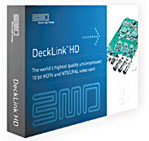
- DVCPRO HD - Apple Final Cut Pro HD
Apple kicked off the NAB week by unveiling Final Cut Pro HD, providing
software-based real-time editing and preview of HD material (www.apple.com/finalcutpro).
For its HD format, Apple has chosen a single answer for capture, storage, and
editing by using Panasonic's professional DVCPRO HD video format (www.panasonic.com/business/provideo/home.asp).
Apple states that Final Cut Pro HD provides playback of up to four streams of
DVCPRO HD video, or up to 10 streams in preview quality when using the new
Xserve RAID storage.

As part of a long-term relationship with Panasonic, Final Cut Pro HD supports
DVCPRO HD capture, edit, and output over the same single FireWire cable that is
currently used for standard-def DV format. Final Cut Pro than can edit the
DVCPRO material in its native format, so there is no format conversion or
re-compression required, nor offline editing in a lower-res format.
This obviously is a great solution if you are using a professional DVCPRO
camera such as the Panasonic VariCam. Apple also has announced its commitment to
support the HDV format in future Final Cut Pro releases.
- Ulead - MediaStudio Pro 7 - HDV
On the Windows platform, Ulead announced the Ulead HD Plug-in for its
MediaStudio Pro 7 professional video editing and DVD authoring software ($299, www.ulead.com).
The HD plug-in adds support for the HDV format, to natively capture, edit, and
output HDV content within MediaStudio Pro 7.
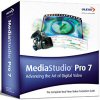
The HD Plug-in automatically detects the JVC JY-HD10U camera, loads the
proper device settings, and converts the MPEG Transport Stream video from the
camcorder to Program Stream format for editing.
- Avid HD - Xpress Pro - DNxHD
Avid also announced plans to provide HD support across its entire DNA product
line of hardware-accelerated nonlinear editing and compositing systems (www.avid.com).
The Avid Xpress Pro editing software for both Windows and Mac platforms will
support a wide range of HD formats in a future version planned for late 2004.
Avid has chosen to take both approaches to HD formats, including the ability to
natively edit uncompressed HD and the compressed HDV MPEG and DVCPRO HD formats,
and also supporting Avid's own intermediate format, called Avid DNxHD.

DNxHD is a 10-bit HD encoding format that permits editing HD material with
the same storage bandwidth and capacity requirements as SD files, including 720p
and 1080i, at data rates ranging from 220 Mbps for 10-bit to 145 Mbps for 8-bit
data.
- Pinnacle - Liquid HD
Pinnacle Systems also announced a Liquid HD upgrade to its Pinnacle Liquid
product line (www.pinnaclesys.com)
Pinnacle plans to provide real-time HDV editing in a choice of formats,
including low-bandwidth HDV, high-quality compressed HD, or full-quality
uncompressed HD.

Pinnacle demonstrated Liquid HD natively editing MPEG compressed video,
taking advantage of the reduced data throughput while still retaining high
quality.
NAB
www.nabshow.com
HDV format
www.hdv-info.org
JVC JY-HD10U HDV camera
www.jvc.com/pro
Sony HDV
www.sony.com/professional
Adobe Premiere Pro
www.adobe.com/premierepro
CineForm Aspect HD / Prospect HD
www.cineform.com
MainConcept MPEG Pro
www.mainconcept.com
Microsoft Windows Media High Definition Video (WMV HD)
www.microsoft.com/windowsmedia
BOXX Technologies HD [pro] RT
www.boxxtech.com
Sonic Solutions DVD Producer- WMV HD Edition
www.sonic.com
Matrox HD
www.matrox.com
Canopus HD
www.canopus.com
1 Beyond
www.1beyond.com
Bluefish444
www.bluefish444.com
BlackMagic Design
www.blackmagic-design.com
Apple Final Cut Pro HD
www.apple.com/finalcutpro
Panasonic DVCPRO
www.panasonic.com/business/provideo/home.asp
Ulead HD Plug-in for MediaStudio Pro
www.ulead.com
Avid HD - Xpress Pro - DNxHD
www.avid.com
Pinnacle Liquid HD
www.pinnaclesys.com
|
